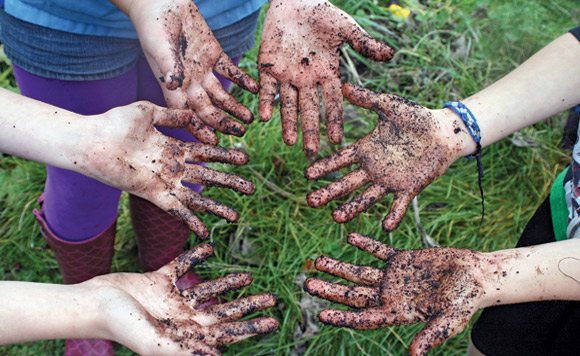– By Dave Friend, aka ‘Mr. Organic’ –
Not only do many hundreds of school-age students and dozens of preschoolers now know what a garlic scape is, but they are also taking ownership of the food they are growing. Children are eating, and enjoying – including the scapes – a wide variety of vegetables that they have grown themselves.
Through the Growing Young Farmers School Program more and more children have become involved in growing health-friendly organic food. The hands-on involvement of growing the food coupled with the importance of learning and knowing how to grow it has not been lost on the vast majority of the children. For instance, an increasing number of them now have their very own ‘organic’ food gardens at home.
A quick, inexpensive and highly productive way of growing food is via Lasagna gardening. It’s a method that has proved very popular with the students. Lasagna gardening is a ‘no dig’ method where, as a general rule, the ‘layers’ are; cardboard (to kill the grass and weeds), newspaper, soil/compost, grass clippings, straw, coffee grounds, leaves, soil/compost. Seeds and/or seedlings are planted in the top layer of soil/compost and then, due to the de-composing of the layers, the plants grow like crazy … as do the worms!
The creation of a number of Hugelkultur beds this past year has been a rich educational experience for students and teachers alike. Hukelcultur (German for hill or mound) beds are no-dig, similar to Lasagna, but they take it to another level, literally! A shallow trench is dug with rotting/decomposing logs, branches and twigs being the bottom ‘layer’. This is then followed by using the same or similar layers used for Lasagna beds (without the cardboard and newspaper) with the result being the creation of a very productive and highly sustainable food-growing structure. Hugelkultur (pronounced Hoo-gul-culture) are no-dig raised beds with a difference. They hold moisture, build fertility, maximise surface volume and are great spaces for growing fruit, vegetables and herbs.
There are many reasons why I believe strongly that some sort of gardening program should be part of the official school curriculum. The vast majority of the 35 million Canadians have less than a weeks supply of food readily available. Vancouver Island has only 72 hours worth of food supply in the event of a disaster. By learning how to grow food, students can play an active role in increasing our island’s sustainability and decreasing our dependence on imported food sources. With an ever-increasing population, what will the food INsecurity situation be when these students are adults and have families to feed? I really believe that they will need to grow food for their families.
Visit www.growingyoungfarmers.ca for more information.




